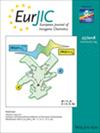Synthesis and Theoretical Evaluation of New Copper(II) Complexes Associated with a Crystalline Schiff Base: DNA/BSA Protein Interaction, Radical Scavenging and Cytotoxicity
IF 2.2
4区 化学
Q3 CHEMISTRY, INORGANIC & NUCLEAR
引用次数: 0
Abstract
A crystalline dihydroxy substituted Schiff base ligand [LH] was involved in the synthesis of three copper(II) complexes viz [Cu(LH)2] (Cu1), [Cu(LH)(bpy)] (Cu2) and [Cu(LH)(phen)] (Cu3) (bpy= 2,2’‐bipyridine and phen= 1,10‐phenanthroline). FTIR, ESI‐MS, elemental analysis, ESR studies and NMR techniques were employed to characterize all the newly synthesized compounds. The molecular structure of ligand and complexes were optimized using density functional theory (DFT) at B3LYP/LanL2DZ levels in the gas phase. According to DFT investigations Cu1 exhibits tetragonally distorted octahedral geometry around Cu(II) while Cu2 and Cu3 appeared in penta‐coordination as distorted trigonal bipyramidal geometry. UV‐Vis, fluorescence and viscosity titrations were used to examine the metal complex interactions with CT‐DNA and BSA protein. The binding results suggest that the complexes bind to DNA via groove binding mode. Molecular docking was performed to analyse the binding interaction of complexes with BSA and DNA. Antioxidant investigation indicates that the Cu1 possesses remarkable ability to scavenge radicals against DPPH due to the lowest IC50 value 211.20 mg/mL. In‐vitro cytotoxicity was assessed against MCF‐7 breast cancer cells where Cu1 was found to have superiority in cytotoxicity with IC50 value 52.35 mm over other analogues.与结晶希夫碱有关的新铜(II)配合物的合成与理论评估:DNA/BSA 蛋白相互作用、自由基清除和细胞毒性
在合成三种铜(II)配合物时使用了一种二羟基取代的希夫碱配体[LH]晶体,即[Cu(LH)2](Cu1)、[Cu(LH)(bpy)](Cu2)和[Cu(LH)(phen)](Cu3)(bpy= 2,2'-联吡啶,phen= 1,10-菲罗啉)。傅立叶变换红外光谱、ESI-MS、元素分析、ESR 研究和 NMR 技术用于表征所有新合成的化合物。在气相条件下,利用密度泛函理论(DFT)在 B3LYP/LanL2DZ 水平上对配体和配合物的分子结构进行了优化。根据 DFT 研究,Cu1 围绕 Cu(II)呈现出四方扭曲八面体几何结构,而 Cu2 和 Cu3 则呈现出五配位的扭曲三叉双锥几何结构。利用紫外可见光、荧光和粘度滴定法研究了金属复合物与 CT-DNA 和 BSA 蛋白的相互作用。结合结果表明,复合物通过沟结合模式与 DNA 结合。分子对接分析了复合物与 BSA 和 DNA 的结合相互作用。抗氧化研究表明,由于 Cu1 的最低 IC50 值为 211.20 毫克/毫升,因此具有显著的清除 DPPH 自由基的能力。在对 MCF-7 乳腺癌细胞进行体外细胞毒性评估时,发现 Cu1 的细胞毒性优于其他类似物,IC50 值为 52.35 mm。
本文章由计算机程序翻译,如有差异,请以英文原文为准。
求助全文
约1分钟内获得全文
求助全文
来源期刊

European Journal of Inorganic Chemistry
化学-无机化学与核化学
CiteScore
4.30
自引率
4.30%
发文量
419
审稿时长
1.3 months
期刊介绍:
The European Journal of Inorganic Chemistry (2019 ISI Impact Factor: 2.529) publishes Full Papers, Communications, and Minireviews from the entire spectrum of inorganic, organometallic, bioinorganic, and solid-state chemistry. It is published on behalf of Chemistry Europe, an association of 16 European chemical societies.
The following journals have been merged to form the two leading journals, European Journal of Inorganic Chemistry and European Journal of Organic Chemistry:
Chemische Berichte
Bulletin des Sociétés Chimiques Belges
Bulletin de la Société Chimique de France
Gazzetta Chimica Italiana
Recueil des Travaux Chimiques des Pays-Bas
Anales de Química
Chimika Chronika
Revista Portuguesa de Química
ACH—Models in Chemistry
Polish Journal of Chemistry
The European Journal of Inorganic Chemistry continues to keep you up-to-date with important inorganic chemistry research results.
 求助内容:
求助内容: 应助结果提醒方式:
应助结果提醒方式:


